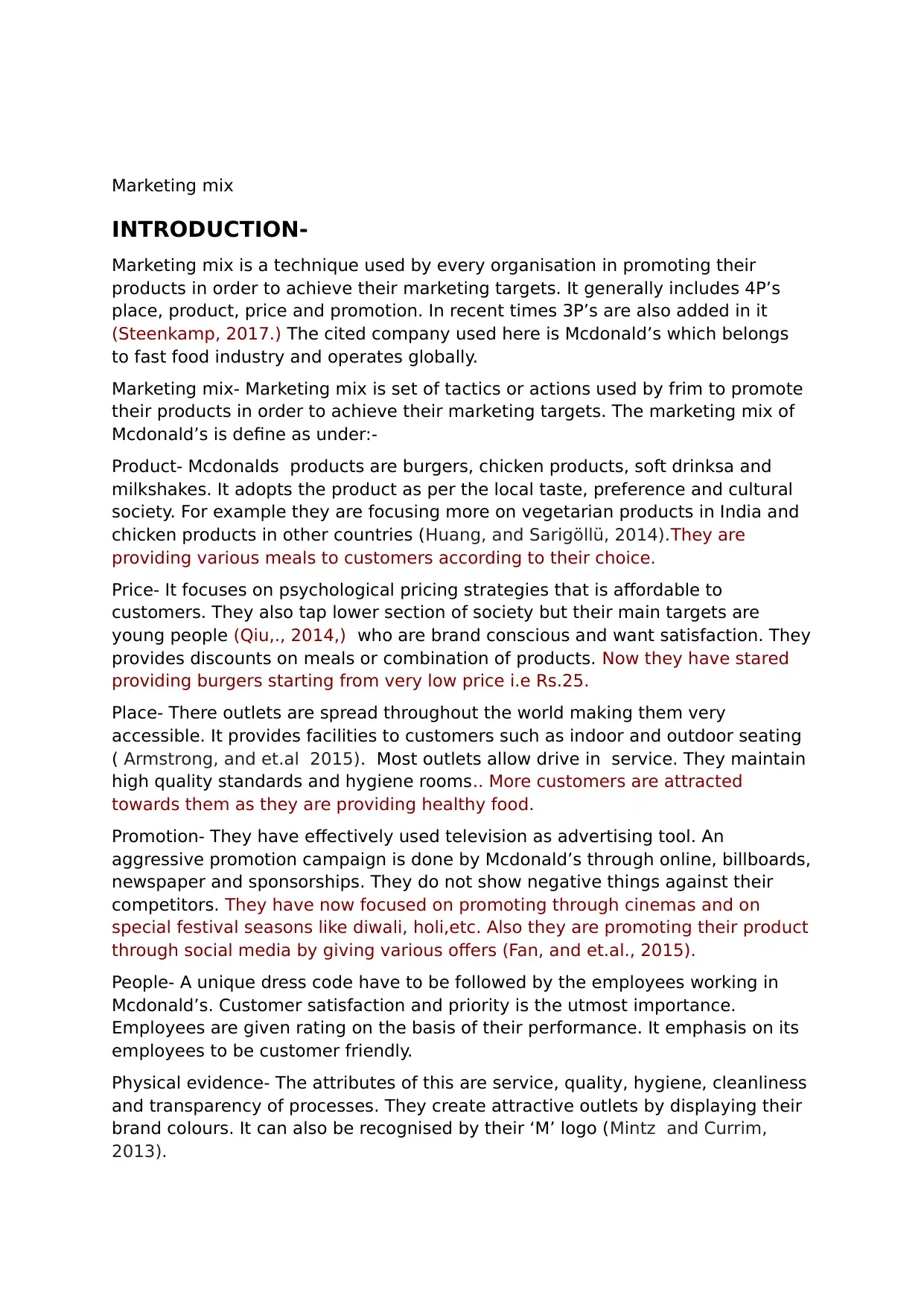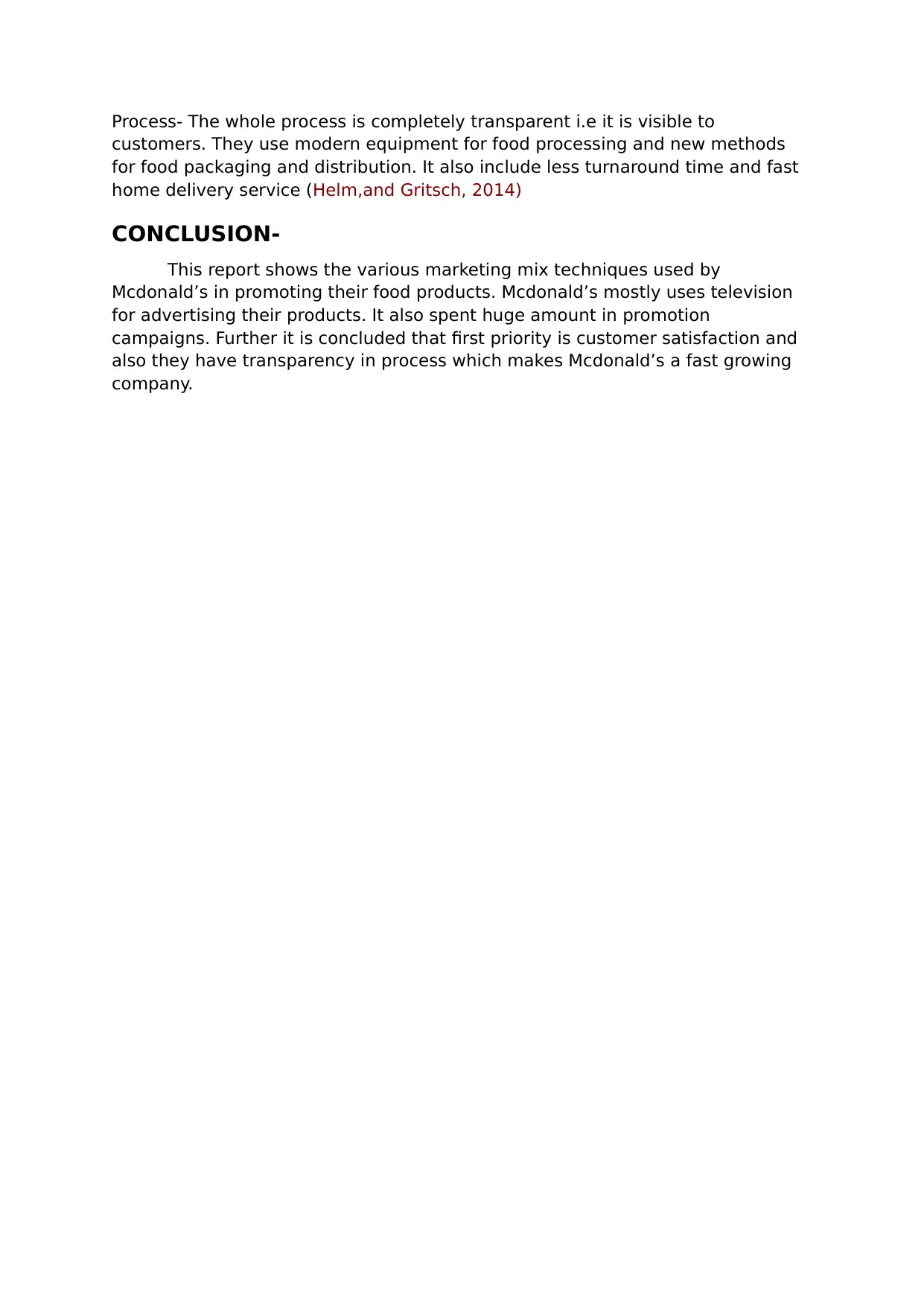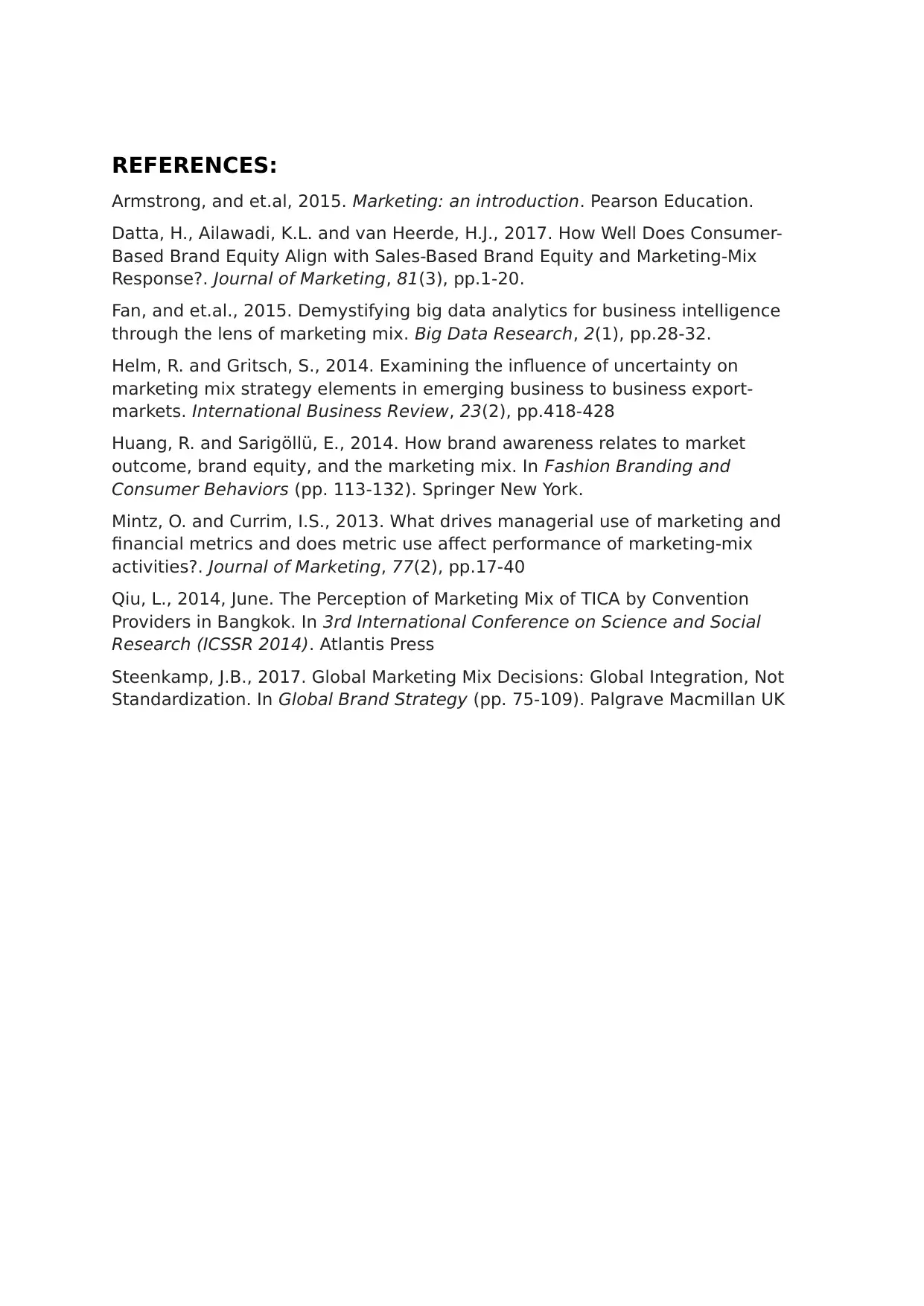Detailed Report: Marketing Mix Strategies Implemented by McDonald's
VerifiedAdded on 2020/06/06
|3
|878
|164
Report
AI Summary
This report provides a detailed analysis of McDonald's marketing mix, examining its strategies across the 7Ps: product, price, place, promotion, people, physical evidence, and process. The report highlights McDonald's product adaptations to local tastes, its psychological pricing strategies targeting young people, and its extensive global presence. It also explores McDonald's effective use of television and social media for promotion, its focus on customer satisfaction through employee training, and its emphasis on transparency in its processes. The report concludes that McDonald's prioritizes customer satisfaction and transparency, contributing to its growth. The report references several academic sources to support its findings. This assignment is available on Desklib, a platform offering past papers and solved assignments for students.

Marketing mix
INTRODUCTION-
Marketing mix is a technique used by every organisation in promoting their
products in order to achieve their marketing targets. It generally includes 4P’s
place, product, price and promotion. In recent times 3P’s are also added in it
(Steenkamp, 2017.) The cited company used here is Mcdonald’s which belongs
to fast food industry and operates globally.
Marketing mix- Marketing mix is set of tactics or actions used by frim to promote
their products in order to achieve their marketing targets. The marketing mix of
Mcdonald’s is define as under:-
Product- Mcdonalds products are burgers, chicken products, soft drinksa and
milkshakes. It adopts the product as per the local taste, preference and cultural
society. For example they are focusing more on vegetarian products in India and
chicken products in other countries (Huang, and Sarigöllü, 2014).They are
providing various meals to customers according to their choice.
Price- It focuses on psychological pricing strategies that is affordable to
customers. They also tap lower section of society but their main targets are
young people (Qiu,., 2014,) who are brand conscious and want satisfaction. They
provides discounts on meals or combination of products. Now they have stared
providing burgers starting from very low price i.e Rs.25.
Place- There outlets are spread throughout the world making them very
accessible. It provides facilities to customers such as indoor and outdoor seating
( Armstrong, and et.al 2015). Most outlets allow drive in service. They maintain
high quality standards and hygiene rooms.. More customers are attracted
towards them as they are providing healthy food.
Promotion- They have effectively used television as advertising tool. An
aggressive promotion campaign is done by Mcdonald’s through online, billboards,
newspaper and sponsorships. They do not show negative things against their
competitors. They have now focused on promoting through cinemas and on
special festival seasons like diwali, holi,etc. Also they are promoting their product
through social media by giving various offers (Fan, and et.al., 2015).
People- A unique dress code have to be followed by the employees working in
Mcdonald’s. Customer satisfaction and priority is the utmost importance.
Employees are given rating on the basis of their performance. It emphasis on its
employees to be customer friendly.
Physical evidence- The attributes of this are service, quality, hygiene, cleanliness
and transparency of processes. They create attractive outlets by displaying their
brand colours. It can also be recognised by their ‘M’ logo (Mintz and Currim,
2013).
INTRODUCTION-
Marketing mix is a technique used by every organisation in promoting their
products in order to achieve their marketing targets. It generally includes 4P’s
place, product, price and promotion. In recent times 3P’s are also added in it
(Steenkamp, 2017.) The cited company used here is Mcdonald’s which belongs
to fast food industry and operates globally.
Marketing mix- Marketing mix is set of tactics or actions used by frim to promote
their products in order to achieve their marketing targets. The marketing mix of
Mcdonald’s is define as under:-
Product- Mcdonalds products are burgers, chicken products, soft drinksa and
milkshakes. It adopts the product as per the local taste, preference and cultural
society. For example they are focusing more on vegetarian products in India and
chicken products in other countries (Huang, and Sarigöllü, 2014).They are
providing various meals to customers according to their choice.
Price- It focuses on psychological pricing strategies that is affordable to
customers. They also tap lower section of society but their main targets are
young people (Qiu,., 2014,) who are brand conscious and want satisfaction. They
provides discounts on meals or combination of products. Now they have stared
providing burgers starting from very low price i.e Rs.25.
Place- There outlets are spread throughout the world making them very
accessible. It provides facilities to customers such as indoor and outdoor seating
( Armstrong, and et.al 2015). Most outlets allow drive in service. They maintain
high quality standards and hygiene rooms.. More customers are attracted
towards them as they are providing healthy food.
Promotion- They have effectively used television as advertising tool. An
aggressive promotion campaign is done by Mcdonald’s through online, billboards,
newspaper and sponsorships. They do not show negative things against their
competitors. They have now focused on promoting through cinemas and on
special festival seasons like diwali, holi,etc. Also they are promoting their product
through social media by giving various offers (Fan, and et.al., 2015).
People- A unique dress code have to be followed by the employees working in
Mcdonald’s. Customer satisfaction and priority is the utmost importance.
Employees are given rating on the basis of their performance. It emphasis on its
employees to be customer friendly.
Physical evidence- The attributes of this are service, quality, hygiene, cleanliness
and transparency of processes. They create attractive outlets by displaying their
brand colours. It can also be recognised by their ‘M’ logo (Mintz and Currim,
2013).
Paraphrase This Document
Need a fresh take? Get an instant paraphrase of this document with our AI Paraphraser

Process- The whole process is completely transparent i.e it is visible to
customers. They use modern equipment for food processing and new methods
for food packaging and distribution. It also include less turnaround time and fast
home delivery service (Helm,and Gritsch, 2014)
CONCLUSION-
This report shows the various marketing mix techniques used by
Mcdonald’s in promoting their food products. Mcdonald’s mostly uses television
for advertising their products. It also spent huge amount in promotion
campaigns. Further it is concluded that first priority is customer satisfaction and
also they have transparency in process which makes Mcdonald’s a fast growing
company.
customers. They use modern equipment for food processing and new methods
for food packaging and distribution. It also include less turnaround time and fast
home delivery service (Helm,and Gritsch, 2014)
CONCLUSION-
This report shows the various marketing mix techniques used by
Mcdonald’s in promoting their food products. Mcdonald’s mostly uses television
for advertising their products. It also spent huge amount in promotion
campaigns. Further it is concluded that first priority is customer satisfaction and
also they have transparency in process which makes Mcdonald’s a fast growing
company.

REFERENCES:
Armstrong, and et.al, 2015. Marketing: an introduction. Pearson Education.
Datta, H., Ailawadi, K.L. and van Heerde, H.J., 2017. How Well Does Consumer-
Based Brand Equity Align with Sales-Based Brand Equity and Marketing-Mix
Response?. Journal of Marketing, 81(3), pp.1-20.
Fan, and et.al., 2015. Demystifying big data analytics for business intelligence
through the lens of marketing mix. Big Data Research, 2(1), pp.28-32.
Helm, R. and Gritsch, S., 2014. Examining the influence of uncertainty on
marketing mix strategy elements in emerging business to business export-
markets. International Business Review, 23(2), pp.418-428
Huang, R. and Sarigöllü, E., 2014. How brand awareness relates to market
outcome, brand equity, and the marketing mix. In Fashion Branding and
Consumer Behaviors (pp. 113-132). Springer New York.
Mintz, O. and Currim, I.S., 2013. What drives managerial use of marketing and
financial metrics and does metric use affect performance of marketing-mix
activities?. Journal of Marketing, 77(2), pp.17-40
Qiu, L., 2014, June. The Perception of Marketing Mix of TICA by Convention
Providers in Bangkok. In 3rd International Conference on Science and Social
Research (ICSSR 2014). Atlantis Press
Steenkamp, J.B., 2017. Global Marketing Mix Decisions: Global Integration, Not
Standardization. In Global Brand Strategy (pp. 75-109). Palgrave Macmillan UK
Armstrong, and et.al, 2015. Marketing: an introduction. Pearson Education.
Datta, H., Ailawadi, K.L. and van Heerde, H.J., 2017. How Well Does Consumer-
Based Brand Equity Align with Sales-Based Brand Equity and Marketing-Mix
Response?. Journal of Marketing, 81(3), pp.1-20.
Fan, and et.al., 2015. Demystifying big data analytics for business intelligence
through the lens of marketing mix. Big Data Research, 2(1), pp.28-32.
Helm, R. and Gritsch, S., 2014. Examining the influence of uncertainty on
marketing mix strategy elements in emerging business to business export-
markets. International Business Review, 23(2), pp.418-428
Huang, R. and Sarigöllü, E., 2014. How brand awareness relates to market
outcome, brand equity, and the marketing mix. In Fashion Branding and
Consumer Behaviors (pp. 113-132). Springer New York.
Mintz, O. and Currim, I.S., 2013. What drives managerial use of marketing and
financial metrics and does metric use affect performance of marketing-mix
activities?. Journal of Marketing, 77(2), pp.17-40
Qiu, L., 2014, June. The Perception of Marketing Mix of TICA by Convention
Providers in Bangkok. In 3rd International Conference on Science and Social
Research (ICSSR 2014). Atlantis Press
Steenkamp, J.B., 2017. Global Marketing Mix Decisions: Global Integration, Not
Standardization. In Global Brand Strategy (pp. 75-109). Palgrave Macmillan UK
⊘ This is a preview!⊘
Do you want full access?
Subscribe today to unlock all pages.

Trusted by 1+ million students worldwide
1 out of 3
Related Documents
Your All-in-One AI-Powered Toolkit for Academic Success.
+13062052269
info@desklib.com
Available 24*7 on WhatsApp / Email
![[object Object]](/_next/static/media/star-bottom.7253800d.svg)
Unlock your academic potential
Copyright © 2020–2025 A2Z Services. All Rights Reserved. Developed and managed by ZUCOL.





